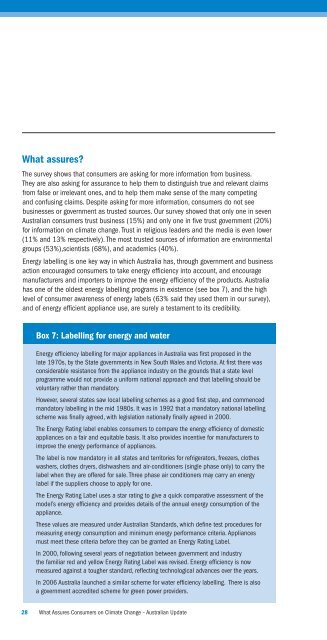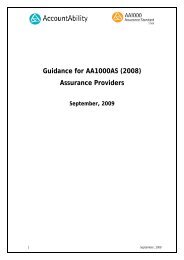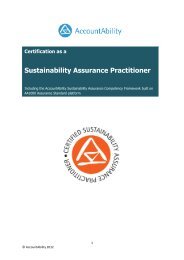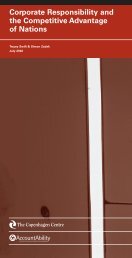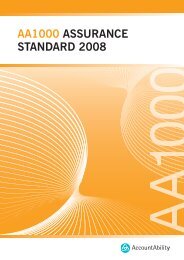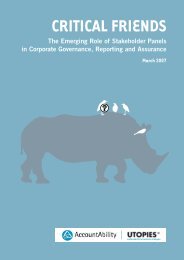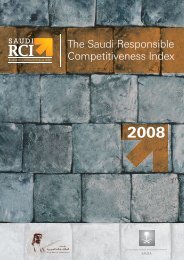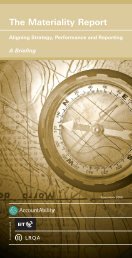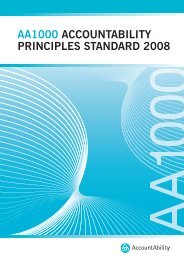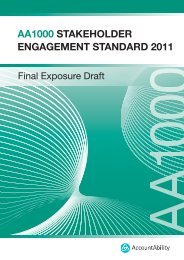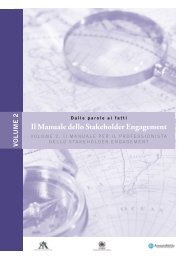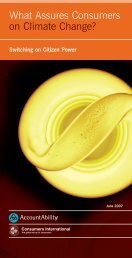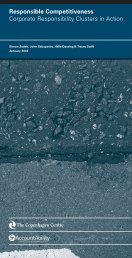Free Download - AccountAbility
Free Download - AccountAbility
Free Download - AccountAbility
- No tags were found...
You also want an ePaper? Increase the reach of your titles
YUMPU automatically turns print PDFs into web optimized ePapers that Google loves.
What assures?The survey shows that consumers are asking for more information from business.They are also asking for assurance to help them to distinguish true and relevant claimsfrom false or irrelevant ones, and to help them make sense of the many competingand confusing claims. Despite asking for more information, consumers do not seebusinesses or government as trusted sources. Our survey showed that only one in sevenAustralian consumers trust business (15%) and only one in fi ve trust government (20%)for information on climate change. Trust in religious leaders and the media is even lower(11% and 13% respectively). The most trusted sources of information are environmentalgroups (53%),scientists (68%), and academics (40%).Energy labelling is one key way in which Australia has, through government and businessaction encouraged consumers to take energy effi ciency into account, and encouragemanufacturers and importers to improve the energy effi ciency of the products. Australiahas one of the oldest energy labelling programs in existence (see box 7), and the highlevel of consumer awareness of energy labels (63% said they used them in our survey),and of energy effi cient appliance use, are surely a testament to its credibility.Box 7: Labelling for energy and waterEnergy effi ciency labelling for major appliances in Australia was fi rst proposed in thelate 1970s, by the State governments in New South Wales and Victoria. At fi rst there wasconsiderable resistance from the appliance industry on the grounds that a state levelprogramme would not provide a uniform national approach and that labelling should bevoluntary rather than mandatory.However, several states saw local labelling schemes as a good fi rst step, and commencedmandatory labelling in the mid 1980s. It was in 1992 that a mandatory national labellingscheme was fi nally agreed, with legislation nationally fi nally agreed in 2000.The Energy Rating label enables consumers to compare the energy effi ciency of domesticappliances on a fair and equitable basis. It also provides incentive for manufacturers toimprove the energy performance of appliances.The label is now mandatory in all states and territories for refrigerators, freezers, clotheswashers, clothes dryers, dishwashers and air-conditioners (single phase only) to carry thelabel when they are offered for sale. Three phase air conditioners may carry an energylabel if the suppliers choose to apply for one.The Energy Rating Label uses a star rating to give a quick comparative assessment of themodel’s energy effi ciency and provides details of the annual energy consumption of theappliance.These values are measured under Australian Standards, which defi ne test procedures formeasuring energy consumption and minimum energy performance criteria. Appliancesmust meet these criteria before they can be granted an Energy Rating Label.In 2000, following several years of negotiation between government and industrythe familiar red and yellow Energy Rating Label was revised. Energy effi ciency is nowmeasured against a tougher standard, refl ecting technological advances over the years.In 2006 Australia launched a similar scheme for water effi ciency labelling. There is alsoa government accredited scheme for green power providers.28 What Assures Consumers on Climate Change – Australian Update


